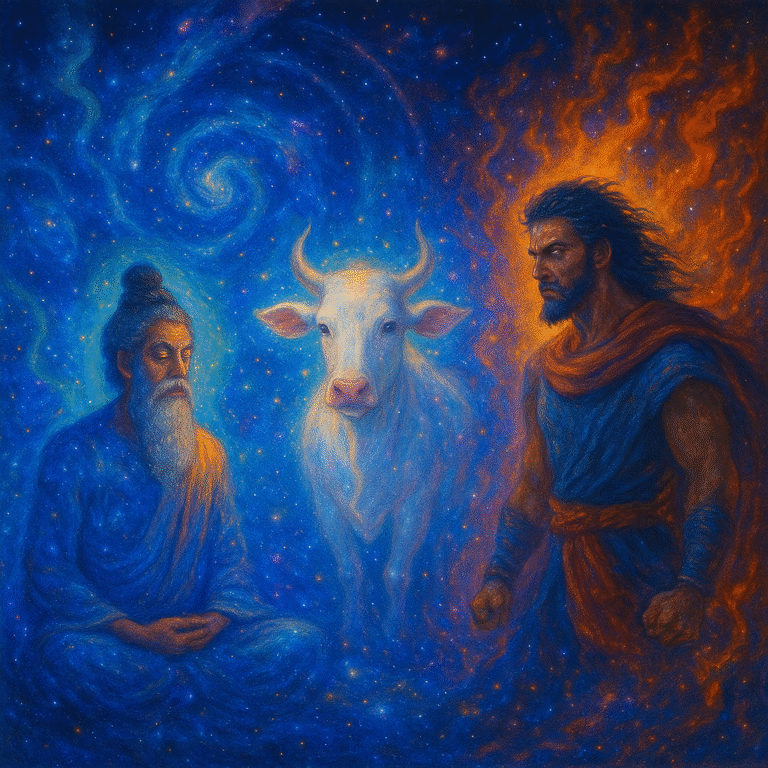The Fire Within: Lessons from Vashishta and Vishwamitra on Desire, Anger, and the Path to Leadership
- Subramaniam PG
- Jun 4
- 4 min read

In the ancient Indian scriptures, the story of Sage Vashishta and King Vishwamitra stands as a profound parable. More than just myth, it is a mirror held up to the human soul. It speaks of power, pride, longing, and fury. At its heart lies a truth relevant to every leader and mentor today: the root of most conflict is found in ungoverned desire and unchecked anger.
Vishwamitra, a mighty king and a great warrior, once sought to take the divine cow Kamadhenu from Sage Vashishta by force. He believed that its celestial powers belonged to the realm of kings and warriors, not sages. But Vashishta, calm yet immovable, defended the cow through spiritual power alone. Vishwamitra was humiliated. Enraged, he renounced his kingdom to seek the power of a Brahmarishi. His path was not one of peace or wisdom but of resentment and ambition. It took him many painful years to purify himself of these base emotions before he could finally become what he desired.
This story, thousands of years old, captures something timeless. It shows how desire and anger—when left unchecked—can disrupt lives, derail careers, and destroy relationships.
We live in a world where ambition is often celebrated without caution. We encourage drive, hunger, and “10x” growth. But we rarely speak of its twin shadow: desire’s potential to blind us. Nor do we talk enough about the volcanic nature of anger—especially among those in leadership.
Desire, in its pure form, fuels vision. It is the spark behind innovation and change. But when desire turns obsessive, it becomes corrosive. Vishwamitra desired spiritual supremacy not to serve others or elevate consciousness, but to match or surpass Vashishta. It was desire born from envy. Such desires do not liberate; they enslave.
Anger is no different. It can arise from wounded pride, unmet expectations, or resistance to control. Like Vishwamitra, many of us have found ourselves angered when someone else stands firm in their truth. We feel rejected. Undermined. Powerless. Instead of examining ourselves, we externalize the conflict. We attack. Or we plot revenge. And in doing so, we destroy our own peace.
The modern workplace is full of echoes of this ancient tale. A talented employee passed over for promotion. A manager feeling threatened by a more capable subordinate. A leader unwilling to accept critique. In each of these, desire and anger quietly shape decisions. They harden hearts. They burn bridges. They lead to broken teams and bruised cultures.
Peter Drucker once said,
“The effective executive manages by objectives. He needs to think through what he is trying to achieve.”
But how often do leaders reflect not just on what they want to achieve, but why? If the “why” is grounded in insecurity or ego, no amount of strategic brilliance will produce sustained success.
The real danger is not desire or anger themselves. These are human emotions. They are not evil. They are signals. The problem begins when leaders stop listening to those signals and start obeying them. Anger, when examined, can lead to clarity. Desire, when purified, becomes purpose.
The transformation of Vishwamitra holds a key. He did not achieve peace through conquest. He achieved it through surrender—first to discipline, then to inner truth. His anger softened. His desire matured. Only then did he reach the level of Vashishta, not through power, but through wisdom.
In his book Emotional Intelligence, Daniel Goleman wrote,
“Leadership is not domination, but the art of persuading people to work toward a common goal.”
This kind of leadership requires emotional mastery. It calls for leaders who are not driven by internal storms, but who can stand like Vashishta—calm, rooted, and self-aware.
There is a deeper message too. Vashishta never tried to compete with Vishwamitra. He stood in his truth and allowed the king to rage, to rebel, to seek. He did not react with ego. He responded with equanimity. That is true mentorship. True leadership. Not the need to prove, but the ability to remain present in the face of provocation.
Many managers and mentors face a similar challenge today. When they are challenged or undermined, they feel the pull to retaliate. But wise leadership does not mean suppressing anger. It means understanding it, owning it, and rising above it.
As leaders, we must ask ourselves: Do we seek power or purpose? Do we react out of fear or respond with clarity? Do we use our influence to dominate, or to elevate?
The story of Vashishta and Vishwamitra teaches that greatness is not the absence of emotion but the transformation of it. What begins as raw desire or angry resistance can become discipline, compassion, and service—if we are willing to do the inner work.
“The leader who rules over self, rules over chaos. In mastering emotion, we master destiny.”
We live in a time where external leadership is abundant, but inner leadership is rare. Yet only the latter sustains. Only that transforms. Only that leaves a legacy.
Let us lead not from the heat of our emotions but from the stillness of our insight.
Reflections and Action
Two Questions for Introspection:
Where in my life or leadership have I allowed desire or anger to cloud my judgment?
When was the last time I examined the deeper motive behind a decision I felt compelled to make?
Two Actionable Steps:
Emotion Journaling: For the next week, write down one instance each day where desire or anger influenced your actions. Reflect on what you felt and why.
Anchor in Purpose: Before making a key decision, ask: “Is this action serving my ego or my purpose?” Pause until the answer is clear.
Citations:
Drucker, Peter F. The Effective Executive. HarperBusiness, 2006.
Goleman, Daniel. Emotional Intelligence: Why It Can Matter More Than IQ. Bantam, 1995.










Comments